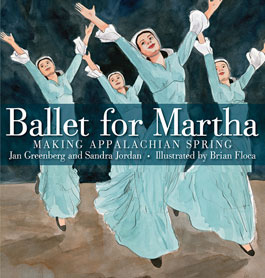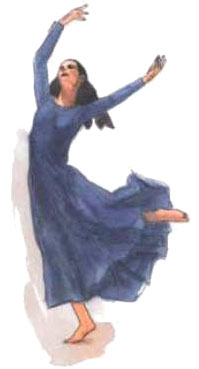 |
|
A Neal Porter Book / Flashpoint /
Roaring Brook Press 2010
written by Jan Greenberg & Sandra Jordan
illustrated by Brian Floca
ISBN: 978-1-59643-338-0
Hardcover picture book, 48 pages
$17.99 |
|
| Get the book: |
|
  |
| |
|
|
| |
 |
|
|
| From the back cover of A Ballet for Martha. Artwork by Brian Floca. |
|
|
|
Ballet for Martha: Making Applalachian Spring is a recipient of the following awards
and distinctions:
Robert F. Sibert Award - Honor
ALA Notable Children's Books
Winner of the NCTE Orbis Pictus Award for Outstanding
NYPL Book for Reading and Sharing List
CCBC Choice (Univ. of WI)
Capitol Choices Noteworthy Titles for Children and Teens
IBBY Honor Books
School Library Journal Best Books 2010
Washington Post Best Books 2010
Kirkus Best Books 2010
PW Best Books 2010
Booklist Editor’s Choice 2010
Boston Globe Best Books
Norn Books Fanfare
Sometimes art is made by one artist, working alone, but sometimes it is the result of artists working together - collaborating - to forge something new. It took more than a year and the imaginations of many talented people for “Appalachian Spring,” the dance created by Martha Graham, to be performed on stage for the first time. The result was an American classic. This is the story of how it happened.
Jan Greenberg and Sandra Jordan tell the story behind the scenes of the collaboration that created “Appalachian Spring,” from its inception through the score’s composition to Martha’s intense rehearsal process. The authors’ collaborator is two-time Sibert Honor winner Brian Floca, whose vivid watercolors bring both the process and the performance to life. |
|
|
| |
From BOOKLIST, AUGUST 2010
“Bookmakers” column by Ilene Cooper
The Art of Making Art
Performance art is almost always a collaboration. Certainly that was true in the creation of the ballet Appalachian Spring, as the picture book Ballet for Martha clearly shows. But books are also collaborations. So how do two authors, one illustrator, and an editor come together to make a book when each may have an individual vision?
In this case, initially, it was double vision. Sandra Jordan and Jan Greenberg have been working together since 1989. Their goal? To find a fresh way to write about art for young people. This effort has been massively successful, producing award-winning books such as Frank O. Gehry: Outside In (2000) and Action Jackson (2002). After writing about Isamu Noguchi in The American Eye (1995), they wanted to say more about this sculptor and were drawn to an exhibit of his dance sets at the Noguchi Museum in Long Island City. Enter their editor at Roaring Brook, With their editor neal Porter, they decided Appalachian Spring—the music, the dance, the set design—would be a more accessible subject for the audience. Once everyone was on board with the concept, it was time to go to work, and for nonfiction writers, the work begins with research.
As Jordan puts it, “Everybody associated with Appalachian Spring seems to have written about it or was interviewed in print.” That meant lots to read, along with plenty of original research, such as watching videos of Graham’s dances with one of her students, who added explanation and depth to what they were seeing. Among the interviewees was the creative director of the Martha Graham Dance Company and one of the original cast members, who was able to describe the colors of the costumes (the 1944 photos had been destroyed).
Jordan and Greenberg’s partnership doesn’t mean each does half the work. Instead, both authors research, write, and rewrite. When they finally pared the manuscript to about 1,400 words (“striving to reflect the rhythm of the dance and music and our sentences”), Porter’s choice of illustrator, Brian Floca, came into the process. Floca, Porter thought, had “a simplicity and purity of line” that would be the right fit.
The collaborators agree that a serendipitous turning point in the project came during an outing to a production of Appalachian Spring in New York. After the performance, they adjourned to dinner, where lively conversation “got the juices flowing,” Porter reports. Floca says he felt the most pressure when re-creating the dance sequences. “I wanted to be faithful to Graham’s techniques and thinking and to depict accurately the particulars of the original production. But I didn’t want the drawings to feel as scrupulous or as labored as that sounds.”
One more invaluable figure entered later in the process, book designer Jennifer Browne, whom her fellow bookmakers uniformly praise. Once there were drawings to show, Floca says all the principals occasionally got together to review dummies and sketches. “In truth, that kind of interplay can sometimes be a tough line for editors, authors, and illustrators to walk, but everyone involved in this book was interested in a genuine way in seeing what everyone else could contribute. We were able to meet only a handful of times as a complete group, but it was a rewarding and enriching way to work.”
Even with more than the usual interaction between writers and illustrator, this merging of talents seems to have been copacetic, especially considering the book was, in part, about the fiery Graham. As Floca sums up, “More drama might have been truer to the spirit of Martha. But it was an overwhelmingly congenial collaboration!” |